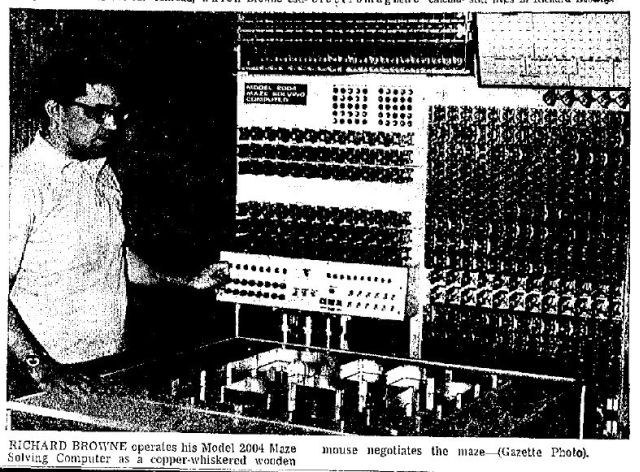Source: Xenia Daily Gazette Mon, May 24, 1971
Computerized mouse maze first of 3 long-term projects for Xenian.
by Ward Pimley – Gazette staff writer
To a research psychologist, running a mouse through a maze to investigate behavior patterns is a common occurrence. But to an electronic engineering drawing specialist who wants to simulate the test, various alterations must be made.
Richard Browne, a drawing specialist in his seventh year with Systems Research Laboratories, Inc. (SRL), has recently finished a lengthy project designed to propel a wooden mouse through a maze with directions being supplied by a computer. He resides at 2004 Tahoe Dr.
COMMONLY, referred to as cybernetics, the system constructed by Browne uses a computer attachment which receives data from the mouse as to its location and the presence or absence of barriers, The computer then tells the mouse which direction to move based upon the data. While the mouse is searching for its "cheese," a metal block which short circuits the electric charge upon contact, the computer is storing in its "memory" information pertaining to the maze; that is, where the alley blocks are and what routes are beneficial to the mouse's search for the goal.
CYBERNETICS is a branch of science which mechanically and electronically attempts to reproduce the human thinking process into machines. Browne's computer, designed to comply with this principle, is programmed to receive information from the mouse, "analyze" the situation, then direct the mouse on its journey. The mouse, one-inch creature carved from balsa wood, has two copper whiskers which signal the computer when the mouse has bumped into a maze barrier.
Directional information is then sent back to the mouse whereupon an electromagnet beneath the aluminum maze moves the mouse in the direction indicated. The electromagnet is driven by two one tenth horsepower engines which control both north-south and east-west movements of the mouse.
THE COMPUTER, 600 pounds of wires and relays, has the capability of processing both partial and total accumulations of "knowledge." The partial knowledge refers to the store of information regarding the squares in which the mouse has investigated, while the total accumulation is the computer's memory of the correct path the mouse should take to solve the maze. After the mouse has found the goal, it may be placed anywhere along the proper path and it will move directly to the goal without either making detours or bumping into alley walls. There is an exploration strategy which the mouse follows, Browne explained, every time it enters a square. Five steps are involved, all occurring within one-tenth of a second. The procedure is repetitive and designed so that the mouse will examine all possible avenues of escape from a square. If the mouse should encounter a wall in one direction, it then turns 90 degrees clockwise. If there is no wall in that direction, the mouse will exit the square. Otherwise, it will turn again to check a new direction. There are 25 squares on the maze with removable walls for reshaping the maze. Browne, said there are 873 duodecillion/(873 followed by 12 zeroes) solvable maze patterns possible in his operation. Should the mouse solve one million maze patterns per second (clearly an impossible task), it would take the mouse 2.7 septillion (seven zeros) centuries to solve all possibilities, Browne said.
THE PROJECT took Browne 10 years to complete, working on and off, he said. The idea for the maze came from a May 1955 issue of Popular Mechanics where an article was printed about a man who had completed such a project. Browne decided to duplicate the feat, although he designed and constructed the computer by himself. While Browne built his unit with spare parts, he said that a computer and maze constructed from new parts (and including labor costs) would cost about $15,000. The present project is completed, Browne said, except for a couple of minor improvements to be made. One of these is to put wheels on the mouse to facilitate easier movements. The other is to replace the magnet in the mouse with a stronger one so that the mouse will not escape from the electromagnet's pull from under the table.
However, Browne is not quitting his dabbling with home made electronic projects. He presently has in mind two further projects to operate from the computer he has already built. One of these is a model railroad, which Browne estimates will take him 15 years to complete (working on and off of course). The other is an electromagnetic calculator which will perform complicated mathematics.
Man's creative urge, it seems, still lives in Richard Browne.
